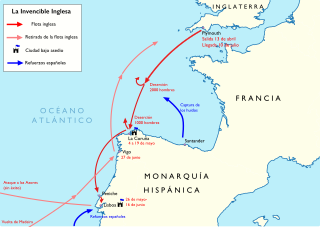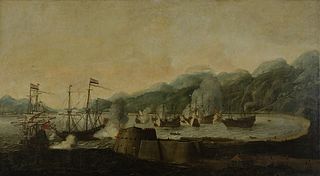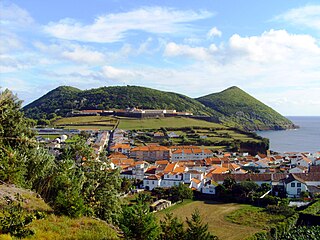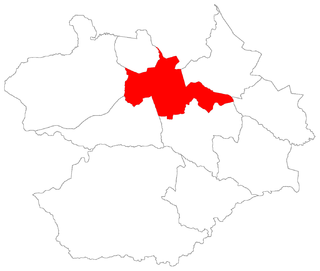
São João da Madeira, is a city and a municipality in northwestern region of the Portuguese Norte region. It's part of the larger Porto Metropolitan Area, located 30 km from central Porto. The population in 2011 was 21,713. With an area of 7.94 km2, it is the smallest municipality in Portugal. In 2010, the city was distinguished in Portuguese quality of life studies as the "Best Municipality to Live In".

Angra do Heroísmo, or simply Angra, is a city and municipality on Terceira Island, Portugal, and one of the three capital cities of the Azores. Founded in 1478, Angra was historically the most important city in the Azores, as seat of the Bishop of the Azores, government entities, and having previously served as the capital city of Portugal during the Liberal Wars. The population in 2011 was 35,402, in an area of 239.00 km2. It was classified as a World Heritage site by UNESCO in 1983.

The English Armada, also known as the Counter Armada or the Drake–Norris Expedition, was an attack fleet sent against Spain by Queen Elizabeth I of England that sailed on 28 April 1589 during the undeclared Anglo-Spanish War (1585–1604) and the Eighty Years' War. Led by Sir Francis Drake as admiral and Sir John Norris as general, it failed to drive home the advantage that England had gained resulting from the failure of the Spanish Armada in the previous year. The Spanish victory marked a revival of Philip II's naval power through the next decade.

The naval Battle of Vila Franca do Campo, also known as Battle of Ponta Delgada and Naval Battle of Terceira Island, took place on 26 July 1582, off the coast of the island of São Miguel in the Portuguese archipelago of the Azores, during the War of the Portuguese Succession. A combined corsair expedition, mainly French, sailed against a Spanish naval force made up of Portuguese and Castilian ships, to preserve control of the Azores under the pretender António, Prior of Crato and to defend the islands from incorporation into the Iberian Union, the largest French force sent overseas before the age of Louis XIV.
The action of 23 March 23 1654 was a naval battle which took place near Colombo, Ceylon, when a force of 5 Portuguese galleons which were escorting 5 merchant galliots to Colombo, fought its way through a Dutch blockading squadron of 3 ships. 2 of the Dutch ships were captured, but the Portuguese in the confusion of having their 2 top officers killed, these ships were recaptured. They ran aground but were refloated.

The action of 30 September 1639 was a naval battle near Mormugão, just south of Goa, India, when a squadron of 9 Dutch ships captured and destroyed 3 Portuguese galleons.

The Fortress of São João Baptista, also known as the Fort of São Filipe or Fort of Monte Brasil is a historic fortress and defensive emplacement, located in the civil parish of Sé, municipality of Angra do Heroísmo in the Portuguese island of Terceira, archipelago of the Azores.

São João Baptista, nicknamed Botafogo ("Spitfire"), was a Portuguese galleon built in the 16th century, around 1530, considered the biggest and most powerful warship in the world by Portuguese, Castillian, and Italian observers of the time.

The naval Battle of the Abrolhos took place on 12 September 1631 off the coast of Pernambuco, Brazil, during the Eighty Years' War. A joint Spanish-Portuguese fleet under admiral Antonio de Oquendo defeated the Dutch after a six-hour naval battle.

The recapture of Bahia was a Spanish–Portuguese military expedition in 1625 to retake the city of Bahia in Brazil from the forces of the Dutch West India Company (WIC).

The Fort of Santo António, also known as the Redoubt of Santo António, is located on the peninsula of Monte Brasil, in the civil parish Sé, in the municipality of Angra do Heroísmo, along the southern coast of Terceira, Portuguese archipelago of the Azores. It is part of the complex of defensive structures of the Fort of São João Baptista, that crossed-fire with the Fort of São Sebastião in the defense of the Bay of Angra.

The História trágico-marítima is a famous 18th-century collection of narrative accounts of the travails and wrecks of several Portuguese ships, principally carracks (naus) on the India run between 1552 and 1602, and the oft-harrowing stories of their survivors.

Sede ("Seat") is a district of the municipality of Santa Maria, in the Brazilian state of Rio Grande do Sul. It is situated in the north portion of Santa Maria. Downtown Santa Maria is one of its bairros (neighbourhoods).

São Bento, commanded by captain Fernão de Álvares Cabral, the son of Pedro Álvares Cabral, was a Portuguese carrack of 900 tons wrecked in April 1554 near the mouth of the Msikaba River, midway between Port Edward and Port St. Johns on the Transkei coast of South Africa. The ship had left Cochin on 1 February 1554 and was en route to Lisbon with a cargo of spices, coconuts, silks, porcelain, cornelian beads, cotton cloth and other luxury goods. There are no hull remains at the site.

Events in the year 1916 in Brazil.













